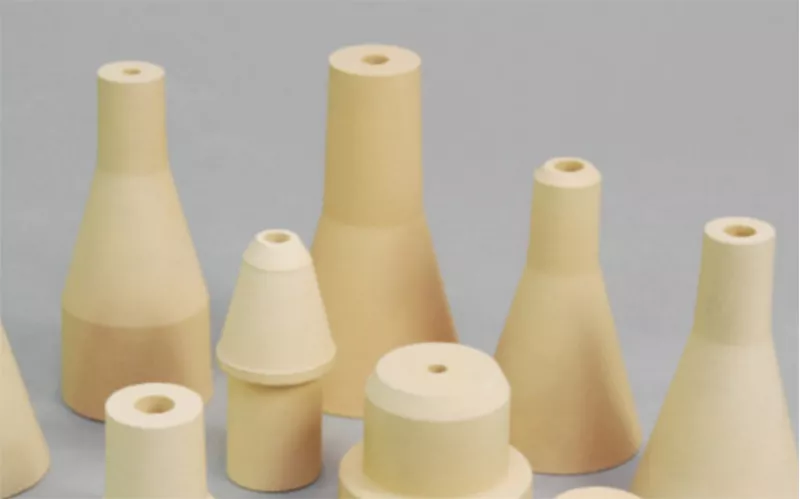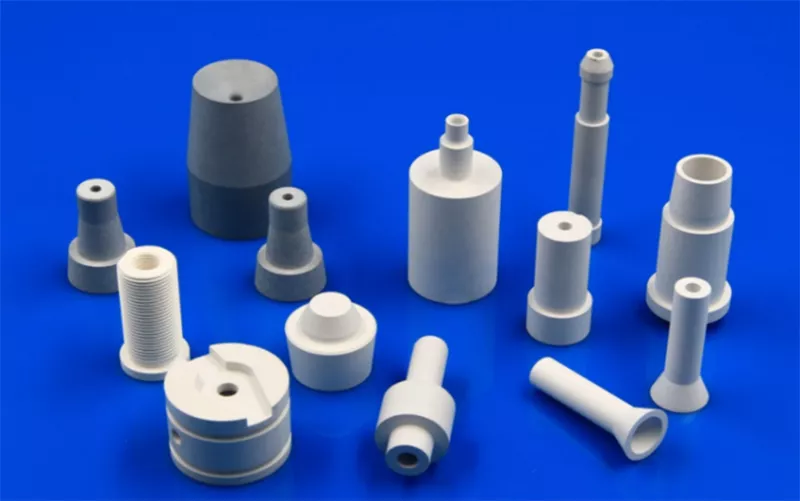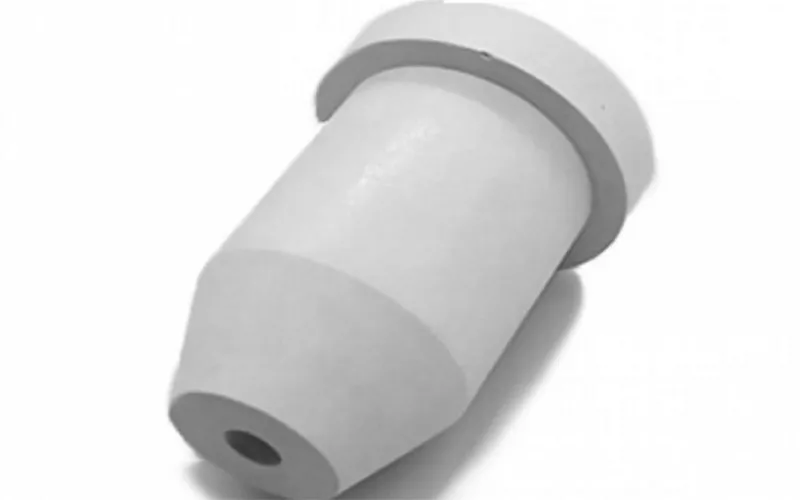
A ceramic nozzle is ideal for your molten metal atomization because it gives precision, control, and durability of your equipment even in harsh conditions. In the heart of your process, whether in additive manufacturing or metallurgy, is a vital component called a ceramic nozzle. This nozzle acts as your transformation process quiet hero, helping shape metal and fire droplets into precise powder. Ceramic nozzles stand out in your metal atomization due to their resilience to very high temperatures, chemical corrosion, and sudden changes in temperature. In this guide, we’ll explore molten ceramic materials and the way they maintain consistency, reduce clogging, and give your industry high-quality, controlled powders.
What are Ceramic Nozzles For Your Molten Metal Atomization Process
-
A nozzle is a hollow tube that controls the direction in which your fluid flows as it enters or exits a chamber. Your ceramic nozzle is a high-performance getaway that is manufactured from materials such as Boron Nitride, which determines your atomized metal powder’s reliability.
-
In your molten metal atomizer, the ceramic nozzle regulates droplets, flow, and determines particle sizes. If your process needs fine control, high durability, and minimal to no contamination, these ceramic nozzles work dependably.
Properties of Ceramic Nozzle Used in Your Molten Metal Atomization
The features of your ceramic nozzles impact performance when exposed to high heat, chemicals, and pressure.
High temperature Stability
-
Ceramic nozzles withstand temperatures exceeding 1600 °C in your molten ceramic environments. Materials such as Alumina and Zirconia actually retain their strength and durability. Plus, they don’t undergo deformation even when continuously exposed to such hell of extremes.
Corrosion Resistance
-
Molten metal ruthlessly attacks lesser materials, such as metals. But with your ceramic nozzle, rest assured, it protects against oxidation and degradation in reactive environments.
Wear Resistance
-
Molten metal atomization involves repeated use and high pressures, all of which lead to erosion if lesser materials are used. Your ceramic nozzles sustain erosion from the metal substances and the high velocity gases, further preventing degradation.
Thermal Shock Resistance
-
I’ve seen the havoc high temperature swings cause on various lesser materials like metals. But for ceramic nozzles, they always withstand sudden heating and cooling, and do not cause cracks on your nozzle body. This ensures your atomization flows uninterrupted.
Ceramic Nozzle Designs That Fit Your Process Demands
Nozzle Geometry and Common Nozzle Designs
-
Your nozzle geometry determines how well your atomization will work because it affects droplet breakup, quality, and powder size. Common designs include straight bore, which yields coarse droplets, converging-diverging, which boosts your atomizing efficiency, and air-assist atomising nozzles, which allow precise intermittent spraying.

Internal Surface Finish
-
A ceramic nozzle with polished internal finishes minimizes the risks of clogging and ensures your metal flows smoothly. The presence and design of subtle tapers in your ceramic nozzle influence the distribution of pressure and help minimize turbulence, increasing your nozzle’s life.
Operating Parameters
-
Operating parameters such as gas pressure and temperature should align with your nozzle design. By matching your needs with function, your process enjoys boosted performance and efficient molten metal atomization.
How Nozzle Design Impacts Atomization
-
The nozzle design your industry chooses greatly determines the consistency of the flow and the efficiency of your atomization. The design controls the size of particles, distribution, and angle of your droplets; therefore, a slight mismatch will compromise the atomization of your molten metal powder quality.
“After switching to a converging-diverging ceramic nozzle for our aluminum powder production, the consistency in particle size improved instantly.”
—Shin C., Engineer, Addpowder Manufacturers
Types Of Ceramic Materials Used in Your Nozzle
Each of the available ceramic materials gives certain capabilities that are ideal for specific conditions of your molten metal atomization.
Alumina
-
Alumina offers affordability, high melting point, and high temperature tolerance. Your Alumina ceramic nozzle resists erosion and delivers high hardness and performance.
Zirconia

-
Zirconia highly resists thermal shock and has low thermal conductivity. Your zirconia nozzles are often ideal for industries involving mechanical vibrations, such as in aerospace powder lines.
Boron Nitride

Boron Nitride is the best material because it offers outstanding features. Your Boron nitride nozzle provides high strength, toughness, high melting point, exemplary thermal shock resistance, as well as machinability. It also gives low wettability with molten metals, which reduces the risk of clogging. In fact, a study on silicon nitride/ boron nitride nanocomposites proved how perfect BN performance is at temperatures even exceeding 1600 °C.
Silicon Carbide
Silicon carbide gives your nozzles outstanding hardness and thermal conductivity. Your SiC nozzles ensure longevity under abrasive metal conditions.
ZSBN Composite

-
ZBSN combines the features of silicon carbide, like exceptional hardness with those of zirconia, like toughness. This boosts balance in your molten metal atomization process.
“We use boron nitride for titanium atomization. Their resistance to clogging and hardness helped cut our downtime by almost 50%.”
—Eliud J., Lead Industrial Engineer, Tekna
How Ceramic Nozzles Influence Your Atomized Powder Quality
-
The nozzle used in your process determines the quality of powder, efficiency, and how clean your atomization will be. Your nozzle controls the flow, grain size, and purity of your atomized metal powders. By using ceramic nozzles with high integrity, your industry benefits from reduced contamination, increased nozzle strength, uniform powder distribution, and a tighter flow.
Applications of Ceramic Atomizing Nozzles in Your Industry
Additive manufacturing and powder metallurgy
-
In your powder metallurgy, nozzle ceramic uses include supporting gas and water atomization. They help produce uniform powders for your 3D printing process.
Aerospace and electronics applications
-
The aerospace industry benefits from the high purity and zero defects provided by ceramic nozzles. Your electronic uses benefit from their fine, consistent particles.
Specialized foundry and casting processes
-
Ceramic nozzles offer high durability in your thermal spray and spray forming. They help reduce downtimes and cut the costs of frequent replacements.
Ceramic Nozzles Vs Other Nozzle Materials
Brass, stainless steel, hardened steel, tungsten carbide, ruby
|
Nozzle Material |
Heat Resistance |
Wear Resistance |
Clogging Resistance |
Cost |
|
Ceramic |
Excellent |
Ecellent |
Low |
Moderate to High |
|
Brass |
Moderate |
Low |
High |
Low |
|
Tungsten Carbide |
High |
High |
Moderate |
High |
|
Ruby |
Very High |
Very High |
Very High |
Very High |
How to Choose the Right Nozzle For Your Industry
Here are tips on selecting atomization nozzles to ensure the success of your operation:
-
Always match the ceramic material to your industry’s temperature and wear resistance requirements.
-
Select the right nozzle design, and the choice should be made based on your industry’s desired powder size.
-
Make sure the nozzle’s surface is polished to ensure your fluid flows smoothly
Where To Purchase Ceramic Nozzles
-
Ceramic nozzles are available worldwide from various suppliers and manufacturers. The price for a ceramic nozzle ranges from $200 to $1,200, depending on the nozzle size and material.
-
For high-quality nozzles, I recommend buying from Georgeous Ceramic Group. I’ve been reading through their reviews, and it’s quite impressive that they offer low minimum order quantities for custom design, and they deliver consistently.
“We’ve been sourcing batches of boron nitride atomizing nozzles and… from Gorgeous for over a year. Their delivery and precision machining have been dependable.”
James D., Procurement Manager, Epson Printers Manufacturers
Frequently Asked Questions About Molten Ceramic Nozzles
Q: How long do ceramic nozzles last on average?
A: They typically last 2 months to over a year, depending on your specific application and care. This is way longer than the lifespan of other materials like metals.
Q: What is the highest temperature that a ceramic nozzle withstands?
A: High-quality ceramic nozzles resist temperatures beyond 1600°C.
Q: Can your ceramic nozzle handle hydraulic and air atomizers?
A: Yes, but that depends on compatibility with your material.
Final Thoughts and Your Takeaway on Ceramic Atomizing Nozzles
In your molten metal atomization, a ceramic nozzle is your scalpel. From precision and cleanliness to thermal toughness and wear resistance, these nozzles deliver irresistible blessings. Select carefully and maintain them well, and your industry will enjoy the elevated process control.
Upgrade your process today by exploring ceramic nozzles customized for your specific uses.